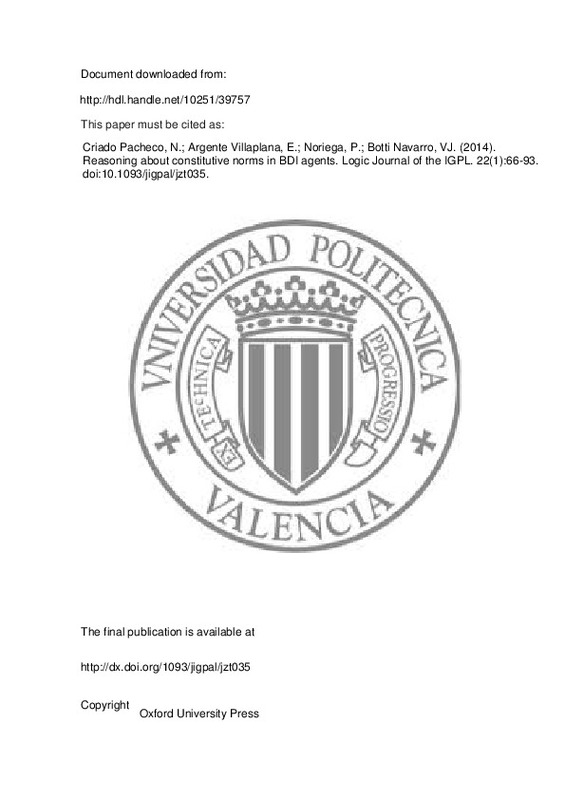JavaScript is disabled for your browser. Some features of this site may not work without it.
Buscar en RiuNet
Listar
Mi cuenta
Estadísticas
Ayuda RiuNet
Admin. UPV
Reasoning about constitutive norms in BDI agents
Mostrar el registro sencillo del ítem
Ficheros en el ítem
| dc.contributor.author | Criado Pacheco, Natalia
|
es_ES |
| dc.contributor.author | Argente Villaplana, Estefanía
|
es_ES |
| dc.contributor.author | Noriega, Pablo
|
es_ES |
| dc.contributor.author | Botti Navarro, Vicente Juan
|
es_ES |
| dc.date.accessioned | 2014-09-19T08:06:40Z | |
| dc.date.available | 2014-09-19T08:06:40Z | |
| dc.date.issued | 2014-02 | |
| dc.identifier.issn | 1367-0751 | |
| dc.identifier.uri | http://hdl.handle.net/10251/39757 | |
| dc.description | This is a pre-copyedited, author-produced PDF of an article accepted for publication in Logic Journal of the IGPL following peer review. The definitive publisher-authenticated version: Criado Pacheco, N.; Argente Villaplana, E.; Noriega, P.; Botti Navarro, VJ. (2014). Reasoning about constitutive norms in BDI agents. Logic Journal of the IGPL. 22(1):66-93 is available online at: http://dx.doi.org/1093/jigpal/jzt035 | es_ES |
| dc.description.abstract | Software agents can be members of different institutions along their life; they might even belong to different institutions simultaneously. For these reasons, agents need capabilities that allow them to determine the repercussion that their actions would have within the different institutions. This association between the physical word, in which agents interactions and actions take place, and the institutional world is defined by means of constitutive norms. Currently, the problem of how agents reason about constitutive norms has been tackled from a theoretical perspective only. Thus, there is a lack of more practical proposals that allow the development of software agents capable of reasoning about constitutive norms. In this article we propose an information model, knowledge representation and an inference mechanism to enable Belief-Desire-Intention agents to reason about the consequences of their actions on the institutions and making decisions accordingly. Specifically, the information model, knowledge representation and inference mechanism proposed in this article allows agents to keep track of the institutional state given that they have a physical presence in some real-world environment. Agents have a limited and not fully believable knowledge of the physical world (i.e. they are placed in an uncertain environment). Therefore, our proposal also deals with the uncertainty of the environment. | es_ES |
| dc.language | Inglés | es_ES |
| dc.publisher | Oxford University Press (OUP): Policy A - Oxford Open Option A | es_ES |
| dc.relation.ispartof | Logic Journal of the IGPL | es_ES |
| dc.rights | Reserva de todos los derechos | es_ES |
| dc.subject | Constitutive norms | es_ES |
| dc.subject | Institutions | es_ES |
| dc.subject | BDI agents | es_ES |
| dc.subject | Multi-agent systems | es_ES |
| dc.subject.classification | CIENCIAS DE LA COMPUTACION E INTELIGENCIA ARTIFICIAL | es_ES |
| dc.subject.classification | LENGUAJES Y SISTEMAS INFORMATICOS | es_ES |
| dc.title | Reasoning about constitutive norms in BDI agents | es_ES |
| dc.type | Artículo | es_ES |
| dc.identifier.doi | 10.1093/jigpal/jzt035 | |
| dc.rights.accessRights | Abierto | es_ES |
| dc.contributor.affiliation | Universitat Politècnica de València. Departamento de Sistemas Informáticos y Computación - Departament de Sistemes Informàtics i Computació | es_ES |
| dc.description.bibliographicCitation | Criado Pacheco, N.; Argente Villaplana, E.; Noriega, P.; Botti Navarro, VJ. (2014). Reasoning about constitutive norms in BDI agents. Logic Journal of the IGPL. 22(1):66-93. doi:10.1093/jigpal/jzt035 | es_ES |
| dc.description.accrualMethod | S | es_ES |
| dc.relation.publisherversion | http://dx.doi.org/10.1093/jigpal/jzt035 | es_ES |
| dc.description.upvformatpinicio | 66 | es_ES |
| dc.description.upvformatpfin | 93 | es_ES |
| dc.type.version | info:eu-repo/semantics/publishedVersion | es_ES |
| dc.description.volume | 22 | es_ES |
| dc.description.issue | 1 | es_ES |
| dc.relation.senia | 250002 | |
| dc.identifier.eissn | 1368-9894 | |
| dc.description.references | Baldi, P., Brunak, S., Chauvin, Y., Andersen, C. A. F., & Nielsen, H. (2000). Assessing the accuracy of prediction algorithms for classification: an overview. Bioinformatics, 16(5), 412-424. doi:10.1093/bioinformatics/16.5.412 | es_ES |
| dc.description.references | Bloch, I. (1996). Information combination operators for data fusion: a comparative review with classification. IEEE Transactions on Systems, Man, and Cybernetics - Part A: Systems and Humans, 26(1), 52-67. doi:10.1109/3468.477860 | es_ES |
| dc.description.references | Casali, A., Godo, L., & Sierra, C. (2011). A graded BDI agent model to represent and reason about preferences. Artificial Intelligence, 175(7-8), 1468-1478. doi:10.1016/j.artint.2010.12.006 | es_ES |
| dc.description.references | Criado, N., Julián, V., Botti, V., & Argente, E. (2010). A Norm-Based Organization Management System. Lecture Notes in Computer Science, 19-35. doi:10.1007/978-3-642-14962-7_2 | es_ES |
| dc.description.references | Governatori, G., & Rotolo, A. (2008). BIO logical agents: Norms, beliefs, intentions in defeasible logic. Autonomous Agents and Multi-Agent Systems, 17(1), 36-69. doi:10.1007/s10458-008-9030-4 | es_ES |
| dc.description.references | Grossi, D., Aldewereld, H., Vázquez-Salceda, J., & Dignum, F. (2006). Ontological aspects of the implementation of norms in agent-based electronic institutions. Computational & Mathematical Organization Theory, 12(2-3), 251-275. doi:10.1007/s10588-006-9546-6 | es_ES |
| dc.description.references | Hübner, J. F., Boissier, O., Kitio, R., & Ricci, A. (2009). Instrumenting multi-agent organisations with organisational artifacts and agents. Autonomous Agents and Multi-Agent Systems, 20(3), 369-400. doi:10.1007/s10458-009-9084-y | es_ES |
| dc.description.references | JONES, A. J. I., & SERGOT, M. (1996). A Formal Characterisation of Institutionalised Power. Logic Journal of IGPL, 4(3), 427-443. doi:10.1093/jigpal/4.3.427 | es_ES |
| dc.description.references | Rawls, J. (1955). Two Concepts of Rules. The Philosophical Review, 64(1), 3. doi:10.2307/2182230 | es_ES |
| dc.description.references | Da Silva, V. T. (2008). From the specification to the implementation of norms: an automatic approach to generate rules from norms to govern the behavior of agents. Autonomous Agents and Multi-Agent Systems, 17(1), 113-155. doi:10.1007/s10458-008-9039-8 | es_ES |







![[Cerrado]](/themes/UPV/images/candado.png)

